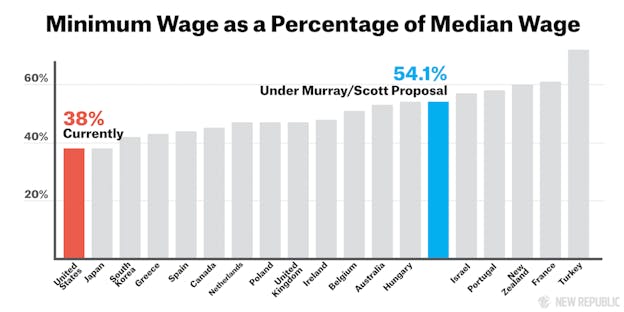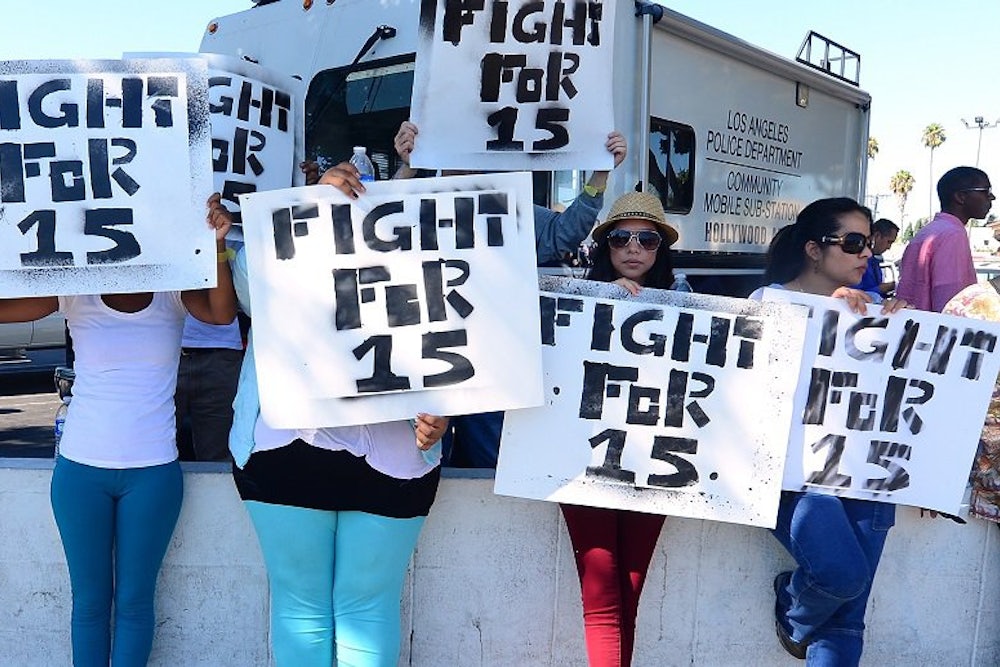On Tuesday, the Los Angeles City Council set itself up to raise its minimum wage from its current level of $9 per hour to $15 per hour in 2020. The bill still faces a final vote. But based on the 14-1 vote on Tuesday, it’s all but certain to pass. It’s a major victory for labor unions and liberal organizations.
It's also part of a wider trend. Los Angeles isn’t the first city to raise its minimum wage to $15. Seattle did so last year and San Francisco followed suit last November. Two weeks ago, New York Governor Andrew Cuomo announced he would impanel a “Wage Board” that allows him to determine whether workers in a certain industry in New York deserve a higher minimum wage. He’s expected to raise the minimum wage for fast food workers, although it’s not clear if he’ll reach the $15 per hour threshold. Meanwhile, a number of companies—from Wal-Mart to McDonald’s—have announced that they were raising the minimum wage for their own employees, although McDonald’s did not require its franchises to do so as well.
This is all clearly a result of the “Fight for $15” movement, which has staged protests and strikes across the country over the past few years, demanding a $15 per hour minimum wage for fast-food workers. The success of the movement leaves a lot of policy writers, myself included, with egg on our face. Vox’s Matt Yglesias already admitted he was “totally wrong” for thinking the protests were a “hopeless waste of time.” In August 2013, The Atlantic’s Derek Thompson wrote, “it is hard for me to see how the higher-wage movement succeeds on the streets.” I made the same argument.
But that was wrong for two reasons. First, I ignored the movement’s ability to influence policymakers at the state and local levels. Congressional Republicans aren’t going to raise the national minimum wage. But the strikes and lobbying efforts of labor groups and progressive organizations have pushed Seattle, San Francisco, Los Angeles and, soon, New York to take action. A number of states have raised their minimum wages as well.
Second, the economy is certainly in better shape now than it was when I wrote that article. But no one would argue that the recovery has been strong. Workers may be in a better place to demand wage increases, but they certainly aren’t in a great spot. Yet, companies are starting to raise their minimum wages. It’s hard to say for sure why these companies are taking this action. At least partially, this is a result of an improving economy. But the “Fight for $15” is certainly having an impact as well.
I share the concerns of Slate’s Jordan Weissmann that this move is risky. The academic evidence is pretty clear that small minimum wage hikes, at most, kill a small number of jobs. But this isn’t a small hike and the employment effects could be significant. One way to examine the potential costs of a minimum wage is to compare it to the median. Arindrajit Dube, an economist at the University of Massachusetts, Amherst, estimates that the minimum wage should equal approximately 50 percent of the median wage. In 2020, the Los Angeles median wage is projected to be about $24, meaning its minimum wage will be over 60 percent of that. Compared internationally, that’s high (this is a chart of Senator Patty Murray and Representative Bobby Scott's proposal to raise the national minimum wage to $12 per hour, but you get the picture):1

The results of the Seattle and San Francisco minimum wage hikes won't be known until they're fully implemented and the economy has time to adjust, which won't happen for a few years.
So this might not be unabashedly good news for fast-food workers in the long run. But the fast-food strikes have shown that they can get results. It would be better if those results raised the minimum wage to 50 percent of the median, as Dube suggests. But “Fight for 50 percent of the median wage” doesn’t have quite the same ring to it as "Fight for $15."
To be fair, that’s not an apples-to-apples comparison. Within Turkey and France, certain areas surely have a higher minimum wage to median wage ratios. But it does show that Los Angeles will have a worryingly high ratio.
